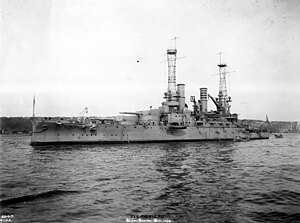 Michigan at a naval review off New York City, October 1912
| |
| Class overview | |
|---|---|
| Name | South Carolina-class battleship |
| Builders | |
| Operators | |
| Preceded by | Mississippi class |
| Succeeded by | Delaware class |
| In service | 1910–1922 |
| Planned | 2 |
| Completed | 2 |
| Scrapped | 2 |
| General characteristics | |
| Type | Dreadnought battleship |
| Displacement | |
| Length | |
| Beam | 80 ft 3 in (24.46 m) |
| Draft | 24 ft 6 in (7.47 m) |
| Installed power |
|
| Propulsion |
|
| Speed | 18.5 kn (21.3 mph; 34.3 km/h) |
| Range | 6,950 nmi (8,000 mi; 12,870 km) at 10 kn (12 mph; 19 km/h) |
| Complement | 51 officers and 881 enlisted men |
| Armament |
|
| Armor | |
Two South Carolina-class battleships, also known as the Michigan class,[B] were built for the United States Navy in the early twentieth century. Named South Carolina and Michigan, they were the first American dreadnoughts—powerful warships whose capabilities far outstripped those of the world's older battleships.
At the turn of the twentieth century, the prevailing theory of naval combat was that battles would continue to be fought at relatively close range using many small, fast-firing guns. As such, each of the ships in the United States' previous Connecticut-class battleships carried many medium-sized weapons alongside four large guns. This paradigm was soon to be subverted, as American naval theorists proposed that a ship mounting a homogeneous battery of large guns would be more effective in battle.
As these ideas began to enjoy wider acceptance, the US Congress authorized the country's navy to construct two small 16,000-long-ton (16,300 t) battleships. This displacement was roughly the same size as the Connecticut class and at least 2,000 long tons (2,000 t) smaller than foreign equivalents. A solution was found in an ambitious design drawn up by Rear Admiral Washington L. Capps, the chief of the navy's Bureau of Construction and Repair; it traded speed for heavy armament and relatively thick armor, both of which were favored by naval theorists of the time.
With their superfiring main armament, press accounts billed South Carolina and Michigan, along with the British HMS Dreadnought, as heralding a new epoch in warship design. All three, however, were soon surpassed by ever-larger and stronger super-dreadnoughts. The class's low top speed of about 18.5 knots (21.3 mph; 34.3 km/h), as compared to the 21-knot (24 mph; 39 km/h) standard of later American battleships, relegated them to serving with older, obsolete battleships during the First World War. After the end of the conflict and the signing of the Washington Naval Treaty, both South Carolinas were scrapped.
Cite error: There are <ref group=upper-alpha> tags or {{efn-ua}} templates on this page, but the references will not show without a {{reflist|group=upper-alpha}} template or {{notelist-ua}} template (see the help page).